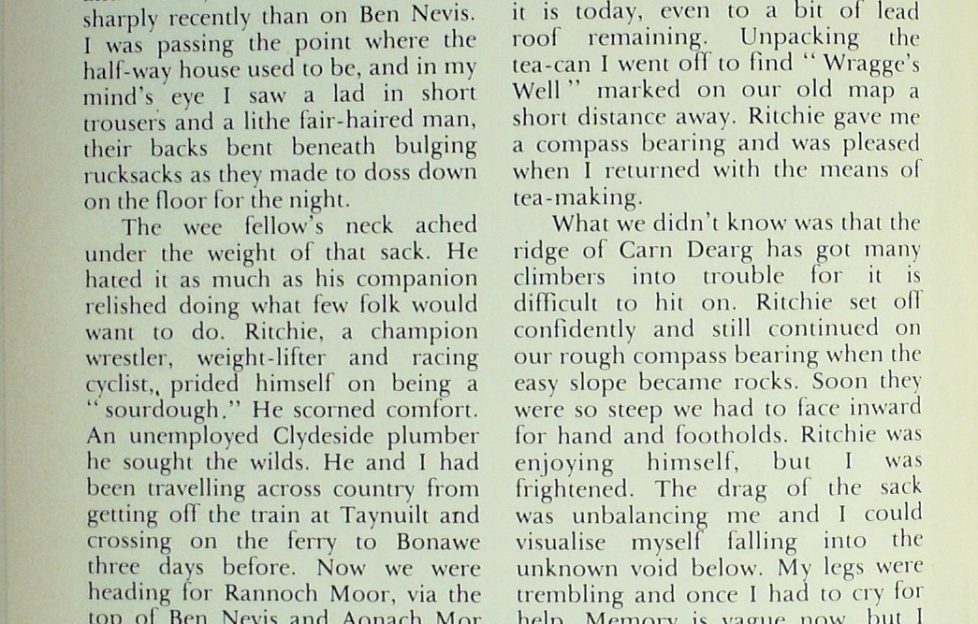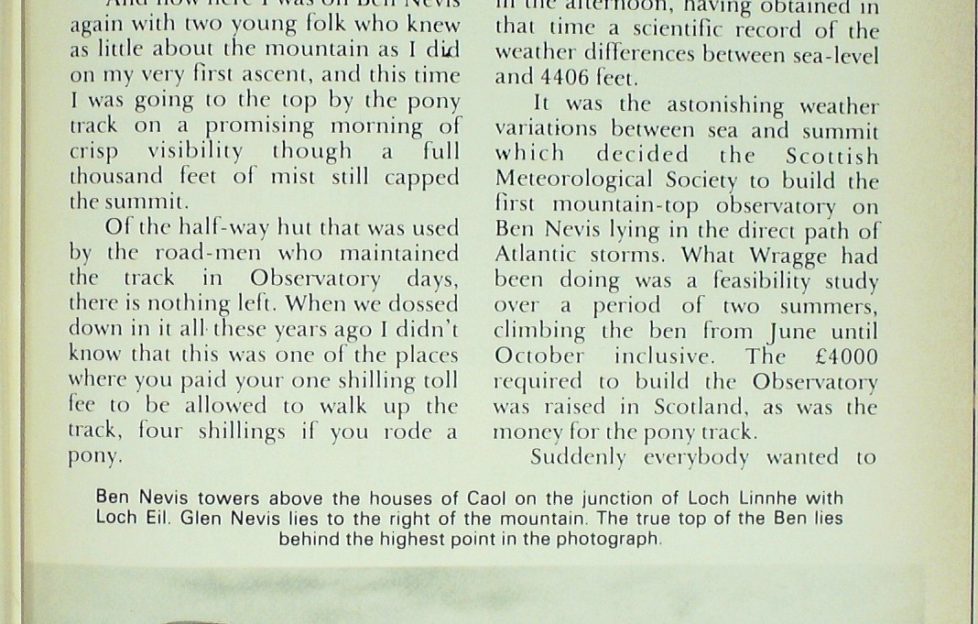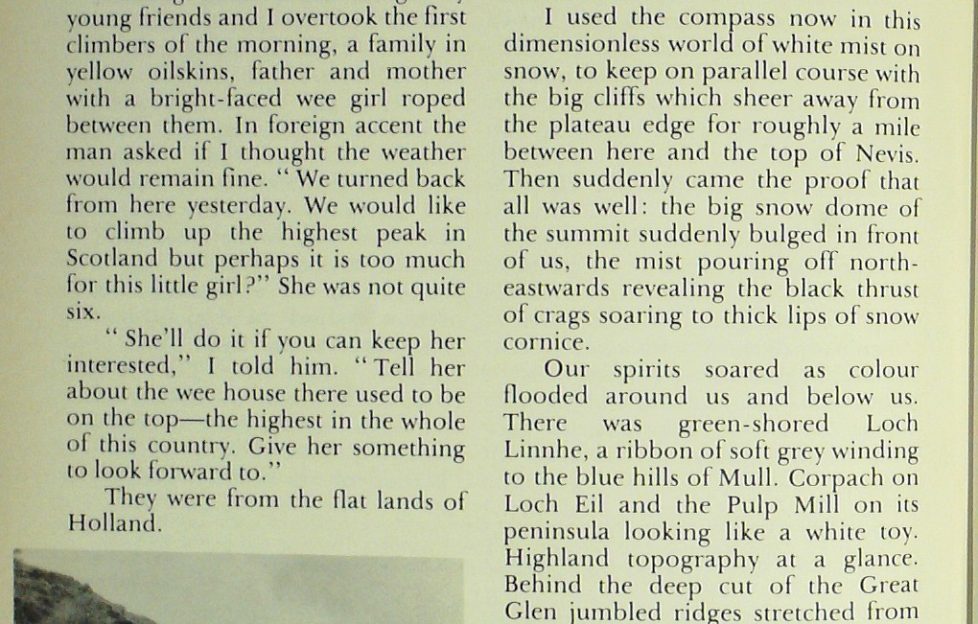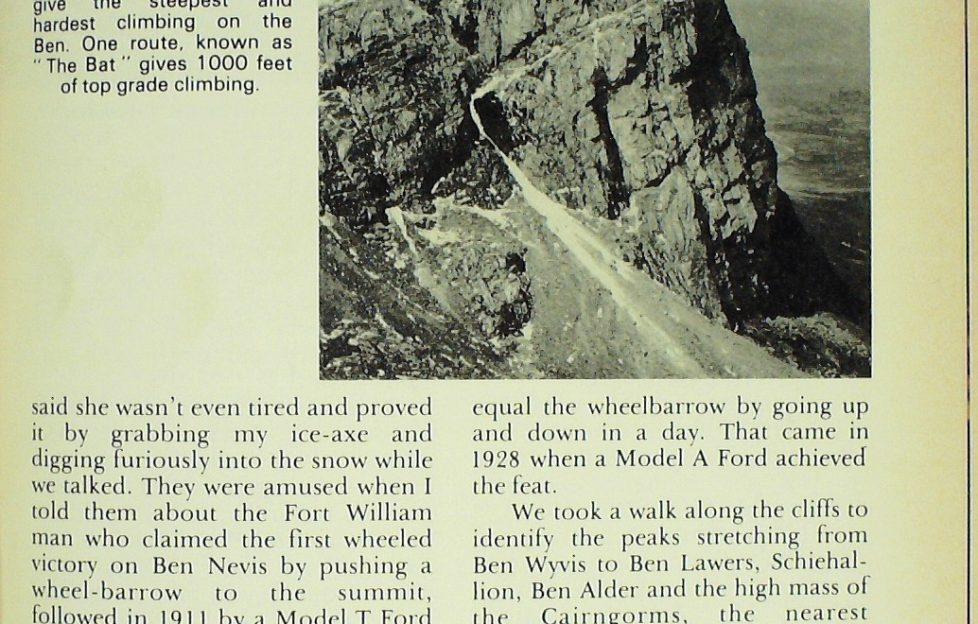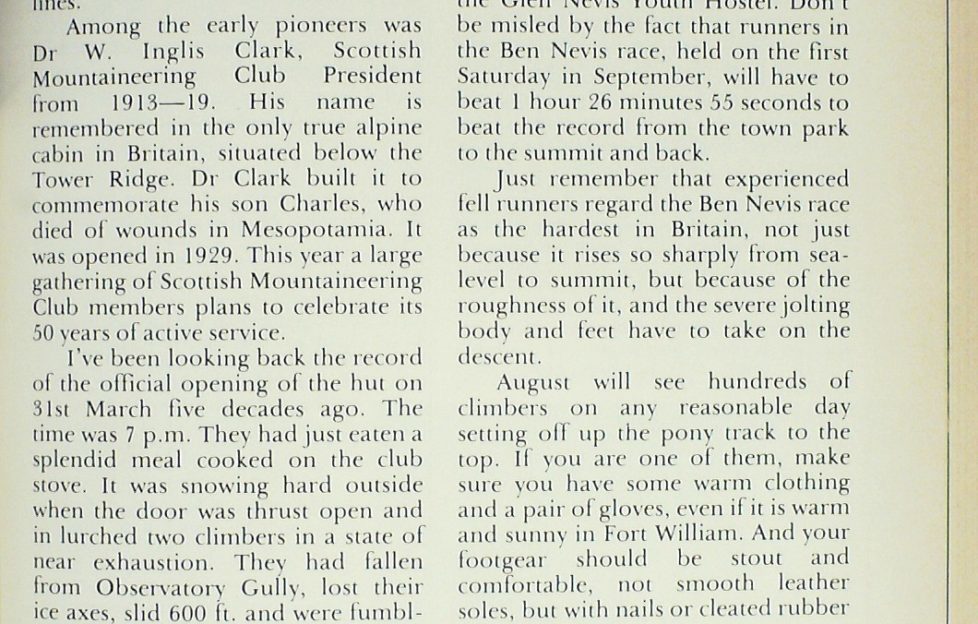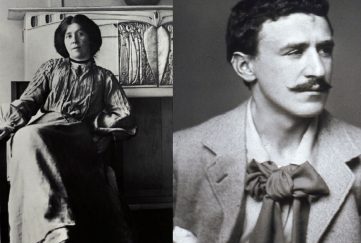Tom Weir | The Big Ben
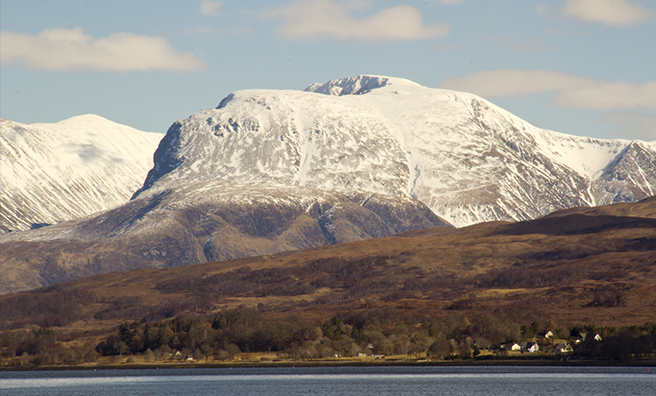
Ben Nevis is the highest and most sought-after mountain in Britain, and here Tom Weir gives us an insight into its climbing history, the first assent by wheelbarrow, and some tips for future climbers
I know now, from my own experience, that your memory of youth gets sharper as you get older. Wandering about the Highlands it happens to me more and more, and nowhere more sharply recently than on Ben Nevis.
I was passing the point where the half-way house used to be, and in my mind’s eye I saw a lad in short trousers and a lithe fair-haired man, their backs bent beneath bulging rucksacks as they made to doss down on the floor for the night.
The wee fellow’s neck ached under the weight of that sack. He hated it as much as his companion relished doing what few folk would want to do. Ritchie, a champion wrestler, weight-lifter and racing cyclist, prided himself on being a “sourdough.” He scorned comfort. An unemployed Clydeside plumber he sought the wilds.
He and I had been travelling across country from getting off the train at Taynuilt and crossing on the ferry to Bonawe three days before. Now we were heading for Rannoch Moor, via the top of Ben Nevis and Aonach Mor and Aonach Beag.
It was bliss to get that bag off, get the Primus going for a “drum- up” and curl up on the floor. But continuous sleep was hard to come by for heavy boots kept thumping in—folk on their way to the summit to await the sunrise— unaware that we were on the floor until their eyes became accustomed to the darkness.
As we went up in the mist and drizzle of the morning we met party after party coming down, all of them bedraggled and disappointed at seeing nothing for their effort. Conditions were still the same when we saw the Observatory building looming ahead, less of a ruin than it is today, even to a bit of lead roof remaining. Unpacking the tea-can I went off to find “Wragge’s Well” marked on our old map a short distance away. Ritchie gave me a compass bearing and was pleased when I returned with the means of tea-making.
A Dangerous Ridge
What we didn’t know was that the ridge of Carn Dearg has got many climbers into trouble for it is difficult to hit on. Ritchie set off confidently and still continued on our rough compass bearing when the easy slope became rocks. Soon they were so steep we had to face inward for hand and footholds.
Ritchie was enjoying himself, but I was frightened.
The drag of the sack was unbalancing me and I could visualise myself falling into the unknown void below. My legs were trembling and once I had to cry for help. Memory is vague now, but I have an image of snow patches and an immense scattering of pink boulders far below and away to our right the narrow ridge we were trying to find. A series of ledgeways led us to it.
Once down on the Aonach Beag col, Ritchie scrapped the idea of humping the bags over the tops in favour of dumping them for a quick race up and down. I really enjoyed myself then, free of ballast. It was fun to be crunching over the ice-hard snow-patches lying in the hollows and then running back down the screes to our bags.
Little could I have guessed after that wet week with Ritchie that it would be the cliffs of Ben Nevis that would draw me back again and again in every season of the year. Or that the least enjoyable part of future days on Britain’s highest mountain would be the plod from Glen Nevis and the descent from the summit after a day on the longest rock climbs in Britain.
And now here I was on Ben Nevis again with two young folk who knew as little about the mountain as I did on my very first ascent, and this time I was going to the top by the pony track on a promising morning of crisp visibility though a full thousand feet of mist still capped the summit.
Of the half-way hut that was used by the road-men who maintained the track in Observatory clays, there is nothing left. When we dossed clown in it all these years ago I didn’t know that this was one of the places where you paid your one shilling toll fee to be allowed to walk up the track, four shillings if you rode a pony.
To build the track cost £800 in 1883, and until it was opened on that date none but a few eccentrics climbed Ben Nevis. Of these the most extraordinary was Clement Wragge, a gangling red-headed Englishman nick-named “The Inclement Wragge’ by the Fort William folk because he climbed the mountain every day regardless of weather. Leaving at five in the morning he aimed to be on the summit at nine and back down in the town at three in the afternoon, having obtained in that time a scientific record of the weather differences between sea-level and 4406 feet.
It was the astonishing weather variations between sea and summit which decided the Scottish Meteorological Society to build the first mountain-top observatory on Ben Nevis lying in the direct path of Atlantic storms. What Wragge had been doing was a feasibility study over a period of two summers, climbing the ben from June until October inclusive. The £4000 required to build the Observatory was raised in Scotland, as was the money for the pony track.
Suddenly everybody wanted to climb Ben Nevis—over 4000 within a year. Many of them would arrive in Fort William by the West Highland Railway which opened in August 1894 bringing the mountain within easy range of the mass of the Scottish population. Trade in the town was brisk. A hotel was built on top to provide bed and breakfast for those wanting to stay for the sunrise, and there was serious talk of extending the railway from the town to the summit.
Talking about these things my young friends and I overtook the first climbers of the morning, a family in yellow oilskins, father and mother with a bright-faced wee girl roped between them. In foreign accent the man asked if 1 thought the weather would remain fine. “We turned back from here yesterday. We would like to climb up the highest peak in Scotland but perhaps it is too much for this liitle girl?” She was not quite six.
“She’ll do it if you can keep her interested,” I told him. “Tell her about the wee house there used to be on the top—the highest in the whole of this country. Give her something to look forward to.”
They were from the flat lands of Holland.
We broke off from the path after crossing the Red Burn to see what we could find in the way of mountain plants among the boulders; fir club and other mosses, alpine ladies mantle, starry saxifrages and the tiny least willow. No snow buntings singing as I had hoped, but I have a feeling they nest here. We were well in the mist at 3500 ft. and at 4000 ft. were on the unbroken snowfield between Cam Dearg and Ben Nevis which Wragge called “The Plateau of Storms”.
I used the compass now in this dimensionless world of white mist on snow, to keep on parallel course with the big cliffs which sheer away from the plateau edge for roughly a mile between here and the top of Nevis. Then suddenly came the proof that all was well: the big snow dome of the summit suddenly bulged in front of us, the mist pouring off north-eastwards revealing the black thrust of crags soaring to thick lips of snow cornice.
Our spirits soared as colour Hooded around us and below us. There was green-shored Loch Linnhe, a ribbon of soft grey winding to the blue hills of Mull. Corpach on Loch Eil and the Pulp Mill on its peninsula looking like a white toy. Highland topography at a glance. Behind the deep cut of the Great Glen jumbled ridges stretched from Knoydart to Kintail and Glen AfTric. There would be even more to see when we reached the top.
The First Wheeled Assent
Our first delightful surprise on getting there was to find the Dutch family already there. The wee girl said she wasn’t even tired and proved it by grabbing my ice-axe and digging furiously into the snow while we talked.
They were amused when I told them about the Fort William man who claimed the first wheeled victory on Ben Nevis by pushing a wheel-barrow to the summit, followed in 1911 by a Model T Ford motor car which took three days to reach the Observatory, but a mere 2 ½ hours to return after a night cooling down.
At the news of the victory of the internal combustion engine over the steeps of the mountain a public holiday was declared in Fort William and a pipe band played to greet the entry of the motor car into the town. The man with the wheelbarrow was there trundling along in the procession. It was to be another thirteen years before the motor car could equal the wheelbarrow by going up and down in a day. That came in 1928 when a Model A Ford achieved the feat.
We took a walk along the cliffs to identify the peaks stretching from Ben Wvvis to Ben Lawers, Schiehallion, Ben Alder and the high mass of the Cairngorms, the nearest approach to true Arctic terrain we have in Scotland and still very white after an exceptionally long winter and cold spring.
Sheltered by the modern “survival hut” which perches on what used to be the Observatory conning tower, I thought about the disappointment Wragge must have felt when the Observatory was built and he was refused the post of Superintendent which he wanted. But you can’t suppress a man of his pioneering spirit.
He had been in Australia, and he went back there, getting his due as Government meteorologist and setting up mountain-top observatories on Mount Wellington and Mount Kodciusko. The world remembers him as its first long-range weather forecaster. He died in 1922
The staff of the Observatory was normally four and they seem to have got on comfortably together with little friction. Visiting students came to stay. One was C.T.R. Wilson, a Nobel Prize winner from Glencorse whose work played an important part in the development in nuclear physics. It was the optical phenomena shown when the sun shone on the clouds surrounding the hilltop that turned his thoughts to imitating them in the laboratory which led to 40 years of tracking atoms.
Living on the Ben
Life on the highest mountain had its share of fun. The team enjoyed the snow, tobogganing from the Observatory to the “Plateau of Storms”—a thrilling half-mile course with a 20 ft. drop and a sensational bit known as McLean’s Steep.
For skating they made a pond on a big tarpaulin stretched on the flat roof; and for curling matches they would descend 2000 ft. to the half-way lochan. In summer they played quoits and amused themselves hurtling rocks over the cliffs to see them bounce and smash with sulphurous smell.
Later, in 1892 they had to warn tourists not to hurl rocks down the cliff. An incredible thing had happened: a family from the north of England had scaled the 2000 ft. cliffs. In four days the Hopkinson brothers pioneered two of the great classics of Scottish climbing, Tower Ridge and Observatory Ridge. Strangely they wrote not a word in any journal about it.
In March two years later a noted Scottish Mountaineering Club alpinist came with a strong party in March and made the first winter ascent of Tower Ridge which Collie described as being comparable with the Italian ridge of the Matterhorn—powerful praise and not over-stated. These great crags are a volcanic cauldron of lava which did not erupt but subsided inside a mass of softer material, its head changing the nature of the surrounding rocks.
It was erosion by moving masses of ice scraping away the softer which uncovered the inside of the mountain and made its lava the north-eastern outside we see today, a superb architectural form of ridge and spire, buttress and arête, gully and chimney. From below they look even more daunting than from above, so all praise to the Hopkinson brothers in finding two of the best natural lines.
Among the early pioneers was Dr W. Inglis Clark, Scottish Mountaineering Club President from 1913—19. His name is remembered in the only true alpine cabin in Britain, situated below the Tower Ridge. Dr Clark built it to commemorate his son Charles, who died of wounds in Mesopotamia. It was opened in 1929. This year a large gathering of Scottish Mountaineering Club members plans to celebrate its 50 years of active service.
A Well-placed Hut
I’ve been looking back the record of the official opening of the hut on 31st March five decades ago. The time was 7 p.m. They had just eaten a splendid meal cooked on the club stove. It was snowing hard outside when the door was thrust open and in lurched two climbers in a state of near exhaustion. They had fallen from Observatory Gully, lost their ice axes, slid 600 ft. and were fumbling their way down when they saw a light beside them. Clark wrote: “Thus early our hut had justified itself in time of danger.”
Time of danger? In fact mountaineering accidents were very few on Ben Nevis until the sudden popularisation of the sport in the late 50s when the climbing revolution took place and gathering streams converged in all seasons on both commonplace, over 50 in two decades, many of the victims totally lacking any idea of what to expect on this most savage of Scottish peaks. There is less excuse for ignorance today than when Ritchie and I went up on our first visit.
How long should you allow yourself to climb Ben Nevis by the pony track? For comfort you want seven hours from Achintee or from the Glen Nevis Youth Hostel. Don’t be misled by the fact that runners in the Ben Nevis race, held on the first Saturday in September, will have to beat 1 hour 26 minutes 55 seconds to beat the record from the town park to the summit and back.
Just remember that experienced fell runners regard the Ben Nevis race as the hardest in Britain, not just because it rises so sharply from sea- level to summit, but because of the roughness of it, and the severe jolting body and feet have to take on the descent.
August will see hundreds of climbers on any reasonable day setting off up the pony track to the top. if you are one of them, make sure you have some warm clothing and a pair of gloves, even if it is warm and sunny in Fort William. And your footgear should be stout and comfortable, not smooth leather soles, but with nails or cleated rubber to give a grip.
Don’t be put off by mere mist for the upper part of the hill is well marked by cairns of stones. You may climb above the clouds or get the same kind of clearing as we did. But don’t be too proud to turn back if the conditions become too wet and stormy for comfort. Go back another day.
The Big Ben is an experience not to be missed.
Read more from Tom Weir next Friday
If you’re planning on tackling the Ben any time soon, the Ben Nevis website has some great advice for new climbers.
More…
Read more from Tom!
We have an extensive archives of Tom Weir’s great columns for The Scots Magazine, and we’re slowly but surely getting them published digitally for new generations to enjoy.
To see the columns we have online so far, click here.


